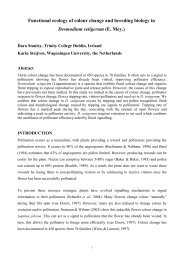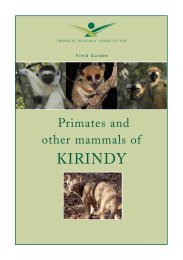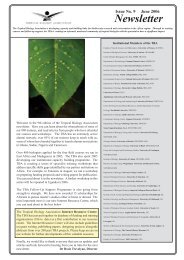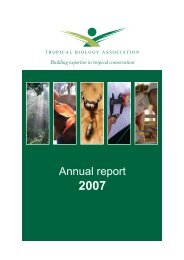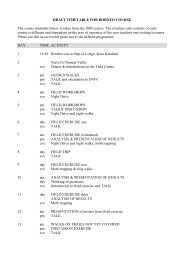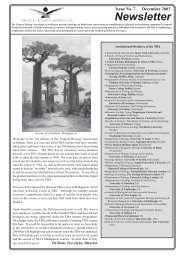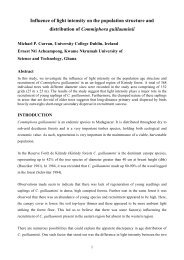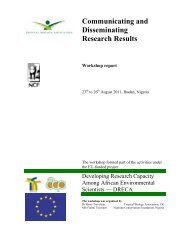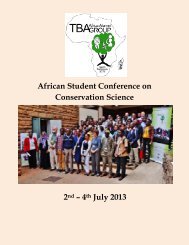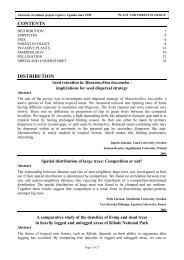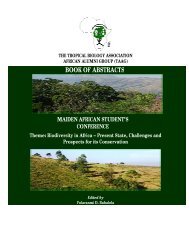Plant and forest ecology - Tropical Biology Association
Plant and forest ecology - Tropical Biology Association
Plant and forest ecology - Tropical Biology Association
You also want an ePaper? Increase the reach of your titles
YUMPU automatically turns print PDFs into web optimized ePapers that Google loves.
Abstracts of student project reports: Madagascar courses since 2002<br />
PLANT AND FOREST ECOLOGY<br />
Is a green bark character an adaptation to dry conditions in Kirindy Forest<br />
Abstract<br />
Green bark trees are common in Kirindy dry <strong>forest</strong>. The green back trait is common among<br />
different families <strong>and</strong> most have no leaves during the dry season. This suggests that green bark in<br />
trees is likely to be an adaptation to the dryness. Observations under the microscope revealed that<br />
strata of green cells are just beneath the strata of dead cells. This may suggest the photosynthetic<br />
role of the bark in absence of leaves in most trees. Thus from our study we could be able to suggest<br />
that green bark assumes the role of leaves in dry season.<br />
Abstract<br />
Assogba Gbed<strong>and</strong>e, National University of Benin, Benin<br />
Aloysius Shija, Sokoine University of Agriculture, Tanzania<br />
Fate of baobab (Adansonia rubrostipa) fruits<br />
in dry deciduous <strong>forest</strong> of Kirindy<br />
A population of Adansonia rubrostipa was assessed for reproductive potential, faunal fruit predation<br />
<strong>and</strong> invertebrate species composition <strong>and</strong> interactions within fruits. Most of the trees in the study area<br />
were found fruiting, producing on average 30.0 fruits. However, due to faunal predation, few of the<br />
seeds will have a chance to germinate. Only 21% of examined fruits did not have external openings;<br />
vertebrates accounted for destroying 34% of fruits, <strong>and</strong> insects – for opening 42%. As traces of insect<br />
feeding were also detected in many vertebrate-opened, crack-opened or even unopened fruits, insects<br />
were the most important baobab fruit predators. A. rubrostipa fruits are important microhabitats for a<br />
number of invertebrate species. 32 species, belonging to 4 classes <strong>and</strong> 11 orders, were detected inside<br />
the fruits, linked with 11 interactions in terms of co-occurrence. Their preferred habitat characteristics<br />
were also recorded. The results enabled us to suggest a general pattern of invertebrate fruit invasion,<br />
leading to complete destruction of pulp <strong>and</strong> seeds.<br />
2003<br />
Piotr Łukasik, Jagiellonian University, Pol<strong>and</strong><br />
Todd Johnson, Livingstone Museum, Zambia<br />
Vertebrate dispersal <strong>and</strong> predation processes of seeds <strong>and</strong> seedlings in a species<br />
of Strychnos in a dry deciduous <strong>forest</strong> in western Madagascar<br />
Abstract<br />
We investigated the effects of distance from a species of Strychnos on seed predation <strong>and</strong> fruit<br />
dispersal by vertebrate fruit eaters. Seed <strong>and</strong> fruit number <strong>and</strong> condition were analysed in quadrats<br />
placed near <strong>and</strong> far to 25 parent tree canopies. Fruit trapping was used to investigate seed dispersal<br />
by arboreal vertebrates dropping fruit whilst feeding, <strong>and</strong> groups of seeds near <strong>and</strong> far from 30<br />
parent canopies were monitored to examine predation rates by terrestrial vertebrates. We postulate<br />
that diurnal vertebrates, particularly Eulemur fulvus, are especially important in seed dispersal <strong>and</strong><br />
that both diurnal <strong>and</strong> nocturnal vertebrates, although especially the latter, act as seed predators.<br />
2004<br />
Isabelle Olivia Baumgartner, University of Zurich, Switzerl<strong>and</strong><br />
Kate Elizabeth McNutt, University of East Anglia, Engl<strong>and</strong><br />
2004<br />
Page 5 of 11




